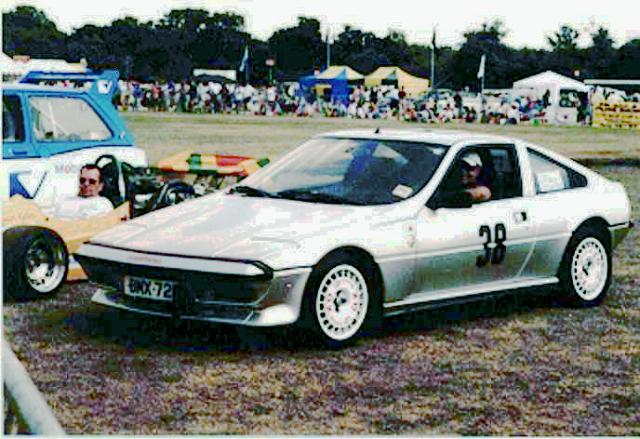Firstly the car is still in one piece more through luck than judgment. I only managed to get in five sprints this year and spun off the track at high speed in every event. One of the most spectacular being at Goodwood on the final bend, the spectators found it very entertaining though and was actually captured in sequence by a photographer, of which I bought a set for posterity. There was also an incident at Watton airfield where I went off backwards through an electric fence into a flock of sheep! In general things have not been too good so far. As an example I managed 2 laps of Goodwood in 2 minutes 23 seconds and should really be looking at 2 minutes 18 seconds for a bit of respectability.

The car does not accelerate fast enough. To combat this I have had a spare head gas flowed and the compression ratio increased to 10.3:1 (from 9.45:1). By skimming the head to achieve this the cam timing will also be altered, effectively moving the camshaft pulley (sprocket) lower down the drive chain and rotating it. So I have modified the camshaft pulley with some kidney shaped slots in the bolt holes to make it into a vernier pulley to give me some adjustment. Piper Cams also reground a camshaft for me (Tagora BP 285 sprint). Hopefully once I have fitted all this, checking the new valve/piston clearance and had the advance curve on the distributor altered to match the new power curve of the engine, some improvement will be had. I do also have an inlet manifold for twin 45-48 DCOE side draught carburetors but I want to see how the 38DGMS Weber I have fitted at present copes with these modifications.
The cars over steering problems. Since having had the suspension modified by LEDA I have fitted 5OOlbs. springs to the rear and increased front toe- in to 1.5 deg. -ve. which improved things. As you will be aware most circuits in the UK. are right handed and the weight distribution of a left hand drive Murena is heavily biased to the nearside rear. What with the fuel tank and an overweight slob in the drivers seat this creates a distinct disadvantage when going round right hand corners, when ideally the weight should be on the inside as much as possible. I have had the car on corner weights recently with me sitting in it to verify this. After weight jacking, where the rear spring platforms are adjusted up or down to put more or less load on that corner (which also affects the front diagonal corner proportionally), some success was achieved. Remembering that 25% of the cars weight in each corner is the ideal (giving a low polar moment of inertia). These are the results.
| LEFT | RIGHT | |
As you can see any reduction in the nearside rear would also reduce the offside front which is not desirable as the fronts should be as close as possible to minimize front braking imbalance.
However what has become clearly apparent from these figures (to me that is, do not give up yet) is that for a mid-engined car which should have a fairly even weight distribution front to rear, you can see that most of the weight is on the rear wheels. Because of this and being such a heavy car it is now not surprising that the car will ultimately oversteer when driven to or near the limits. Oh well back to the Slimfast!
Apart from all that the brakes on the Murena have always been pretty good, but after reading one "Go-Faster" magazine too many and lack of rear caliper overhaul kits, I decided to upgrade the brakes. A firm called Hi- Tec Motor Sport, Dartford, Kent. agreed to my request.
They fitted to the rear, Cosworth calipers and discs, and to the front, Volvo 240. 4 pot calipers and twin ventilated cross drilled discs (Mercedes ?), all with stainless steel braided hoses.
After some experimentation it was decided to remove the pressure reduction valve from the rear circuit (this is in front of the offside rear wheel arch) and to fit a proportional pressure regulating valve to the front circuit. This had the effect of making the back brakes work at maximum pressure at all times and to be able to reduce the fronts as they are quite fierce, to balance out the front to rear bias according to the road/track conditions. The only downside to all this is the fact that the brake pedal travel has increased due to the extra volume of brake fluid that is required to move the extra piston volume. A larger compatible master cylinder would solve this, has anyone any ideas ?
I have also fitted front and rear strut braces to hopefully stiffen up the chassis and a decent steering wheel to hang onto when bouncing across outfields or into Armco!
Graham Pryme.